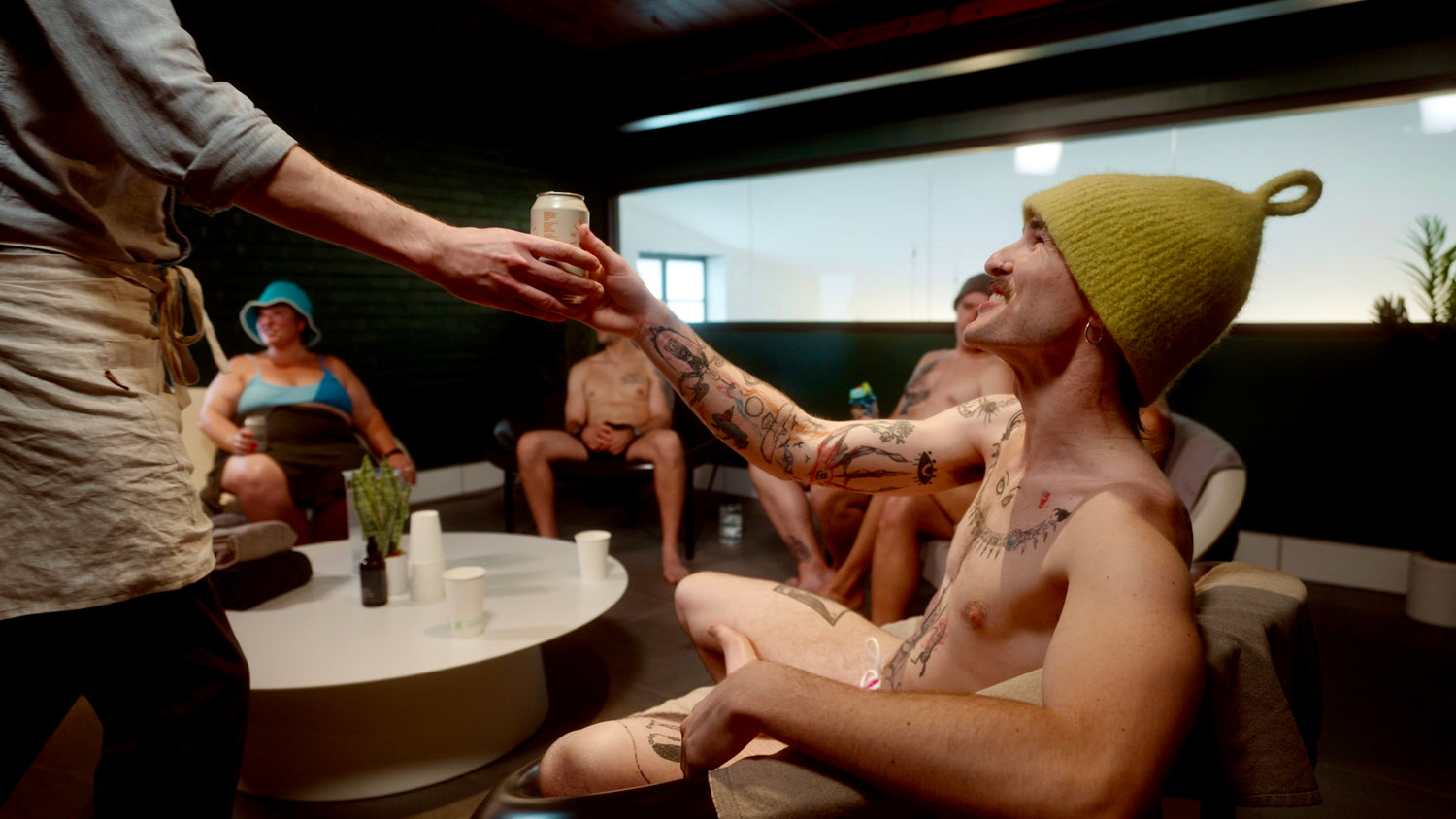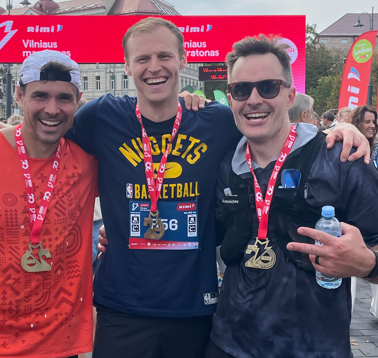Mindful Meetings: Walking, Sauna, and the Power of Presence
5 Min Read / Gavin JociusWhat if your next meeting didn’t leave you feeling drained?
At Sauna House, we’re rethinking the way we connect—with each other, with our bodies, and with our surroundings. We recently discovered a great name for it — Zone 2 Meeting: a gathering rooted in movement, presence, and intention. These meetings happen in the sauna or on a walk, away from screens and distractions, while your heart is gently working in what’s known as Zone 2—a physiological sweet spot that builds endurance and burns fat while keeping your body calm.
As someone who trained for and completed a 100-mile ultramarathon, I discovered Zone 2 initially from a failed ultra attempt where I had yet to discover that running based one’s heartrate is the key to long distance success. It changed the way I trained, and eventually, the way I now try to hold meetings. Now, mostly on Friday afternoons, I host sauna or walking meetings. No phones, no laptops—just a slightly elevated heart rate, conversations and presence.

What Is Zone 2 and Why Does It Matter?
Zone 2 is a training zone where your heart rate is elevated but still comfortable enough to hold a conversation. It’s often 60–70% of your maximum heart rate, depending on your fitness level. The magic of Zone 2 lies in its efficiency: it strengthens the heart, improves mitochondrial function, and teaches the body to burn fat as fuel, all without the wear and tear of high-intensity workouts [1][2].
However, most people think they’re training in Zone 2 when they’re not. As the team at Strava explains, we often drift into higher intensities without realizing it, losing the unique benefits of this low, steady zone [1]. Heart rate–based methods like the MAF (Maffetone) Method help ensure you're actually staying in this optimal range [3][4].
But Zone 2 isn’t just for athletes—it’s a place where movement and mindfulness meet. And that makes it a perfect foundation for meetings that are more human, less hurried.

Modern Meetings Are Broken
Let’s face it: most meetings today happen online, where half the attendees are multitasking.
Whether you’re checking Slack, scrolling emails, or clicking through tabs, traditional meetings often fall victim to a divided attention span. According to a Harvard Business Review piece, poorly structured meetings contribute to disengagement, wasted time, and even stress [5].
And don’t even get us started on Zoom fatigue.
What if, instead of staring at a screen, you could walk side by side with a colleague in nature—or sit together in silence and heat, breathing in sauna steam, letting the rhythm of the sauna guide the conversation?
Zone 2 Meetings do just that.
Walking Meetings, Done Right
Walking meetings aren’t new. But when done intentionally, they become a powerful tool for creativity and collaboration. Research shows that walking improves divergent thinking—a key component of innovation—and enhances overall cognitive flexibility [6].
In fact, a well-known Stanford study found that walking increases creative output by an average of 60% [6]. The Harvard Business Review notes that walking side-by-side (rather than face-to-face) removes some of the pressure of formal meetings, helping people feel more open and communicative [5].
And if you take your walking meeting into a natural setting, the benefits multiply.
Forest Bathing: The Nature Prescription
Forest bathing, or shinrin-yoku, originated in Japan and simply means immersing yourself in a natural setting with all five senses. It’s not hiking for exercise—it's walking slowly and mindfully, noticing light, sounds, smells, and textures. The practice has been widely studied and found to lower cortisol, reduce blood pressure, and elevate mood [7].
A National Geographic article explains that just two hours in the forest can significantly reduce stress and boost immune function, with effects lasting for days [8]. Meanwhile, a study published by the American Psychological Association found that interacting with nature improves memory performance and attention by 20% [9].
In essence, a forest walking meeting is a form of Zone 2 meeting that engages your body and restores your mind. It’s a way to connect not just with another person, but with the world around you.

Sauna as a Meeting Room
While walking has its benefits, sauna offers another dimension: heat-induced calm and powerful physiological changes.
During a sauna session, your heart rate typically rises into Zone 2 territory, especially during longer or repeated rounds. This mimics the effects of aerobic exercise and has been shown to improve cardiovascular health, reduce inflammation, and even enhance longevity [10]. And unlike a boardroom, saunas promote presence. The phone stays outside. The attention comes inward—or toward the people around you.
At Sauna House, our private sauna rooms are perfect for group meetings of up to 8 people. We also offer full bathhouse rentals for larger offsites, creative sessions, or team-building events. These spaces are intentionally designed to be screen-free, social, and soothing—perfect for sparking meaningful conversation and clear thinking.

Why Zone 2 Meetings Work
Here’s what happens in a Zone 2 Meeting:
- Your body moves or heats up gently, entering an aerobic state
- Your mind becomes more alert but not stressed
- You’re not scrolling, typing, or being interrupted
- You’re connecting in a natural, grounded way
And yes—you’re also burning calories while doing it [2][10]. Not a bad bonus.
Book Your Next Meeting
Whether you're leading a team, catching up with a friend, or hashing out a creative idea, try swapping your next sit-down meeting for a Zone 2 Meeting you can also find us this summer at different mobile pop-up experiences.
Walk. Sweat. Be present.

This blog post was researched, edited and written by Gavin Jocius
Gavin Jocius is the Chief Digital and Marketing Officer for Sauna House and a co-owner of Sauna House Durham. With a deep passion for bathing culture, he has immersed himself in sauna traditions across Japan, Europe, and North America, shaping the unique experience offered at Sauna House. A regular in the Durham sauna, Gavin enjoys connecting with customers and sharing his enthusiasm for contrast therapy and the art of relaxation. He has worked in digital marketing and eCommerce for over 25 years having build and run numberous companies.
An avid traveler and adventure-seeker, Gavin spends his free time surfing, snowboarding, ultra-running, and spearfishing—always in pursuit of the next Misogi Challenge. When he’s not exploring new cultures or studying global bathing traditions, he enjoys the slower pace of farm life, running a horse farm with his wife and two daughters. Whether in the sauna or the great outdoors. Next time you are in Sauna House, feel free to say high to Gavin and let him know if you enjoyed this article.
Book your next Zone 2 Meeting
Book NowSources Cited
1. Strava. (n.d.). You’re Not Really Training in Zone 2—You Just Think You Are. Strava Stories. Retrieved from https://stories.strava.com/articles/youre-not-really-training-in-zone-2-you-just-think-you-are
2. Juniper. (n.d.). Zone 2 Running: What It Is & Why You Should Be Doing It. MyJuniper Blog. Retrieved from https://www.myjuniper.com/blog/zone-2-running
3. Run and Become. (n.d.). Low Heart Rate Training: The Maffetone Method. Run and Become. Retrieved from https://www.runandbecome.com/running-training-advice/low-heart-rate-training
4.Parnell, K. (n.d.). Run Training: Heart Rate, MAF, Power and Pace. ChiliTri. Retrieved from https://chilitri.com/blog/karenparnell01@hotmail.com/run-training-heart-rate-maf-power-and-pace
5.Knight, R. (2015, August 13). How to Do Walking Meetings Right. Harvard Business Review. Retrieved from https://hbr.org/2015/08/how-to-do-walking-meetings-right
6. Forbes Business Council. (2023, February 15). How Leaders Can Hold Walking Meetings Successfully. Forbes. Retrieved from https://www.forbes.com/councils/forbesbusinesscouncil/2023/02/15/how-leaders-can-hold-walking-meetings-successfully/
7. Howard, B. C. (2019, March 12). Forest Bathing: A Walk in the Woods Could Boost Your Health. National Geographic. Retrieved from https://www.nationalgeographic.com/travel/article/forest-bathing-nature-walk-health
8. Berman, M. G., Jonides, J., & Kaplan, S. (2008). The Cognitive Benefits of Interacting With Nature. Psychological Science, 19(12), 1207–1212. https://doi.org/10.1111/j.1467-9280.2008.02225.x
(Direct link to PDF: https://www.apa.org/pubs/journals/releases/xlm-a0036577.pdf)
9. Lazarus, N. R., & Harridge, S. D. R. (2019). Exercise, Physical Activity and the Aging Process: A Review of Reviews. PubMed Central, Aging Research Reviews, 51, 32–52.
1. Strava. (n.d.). You’re Not Really Training in Zone 2—You Just Think You Are. Strava Stories. Retrieved from https://stories.strava.com/articles/youre-not-really-training-in-zone-2-you-just-think-you-are
2. Juniper. (n.d.). Zone 2 Running: What It Is & Why You Should Be Doing It. MyJuniper Blog. Retrieved from https://www.myjuniper.com/blog/zone-2-running
3. Run and Become. (n.d.). Low Heart Rate Training: The Maffetone Method. Run and Become. Retrieved from https://www.runandbecome.com/running-training-advice/low-heart-rate-training
4.Parnell, K. (n.d.). Run Training: Heart Rate, MAF, Power and Pace. ChiliTri. Retrieved from https://chilitri.com/blog/karenparnell01@hotmail.c... See all sources
1. Strava. (n.d.). You’re Not Really Training in Zone 2—You Just Think You Are. Strava Stories. Retrieved from https://stories.strava.com/articles/youre-not-really-training-in-zone-2-you-just-think-you-are
2. Juniper. (n.d.). Zone 2 Running: What It Is & Why You Should Be Doing It. MyJuniper Blog. Retrieved from https://www.myjuniper.com/blog/zone-2-running
3. Run and Become. (n.d.). Low Heart Rate Training: The Maffetone Method. Run and Become. Retrieved from https://www.runandbecome.com/running-training-advice/low-heart-rate-training
4.Parnell, K. (n.d.). Run Training: Heart Rate, MAF, Power and Pace. ChiliTri. Retrieved from https://chilitri.com/blog/karenparnell01@hotmail.com/run-training-heart-rate-maf-power-and-pace
5.Knight, R. (2015, August 13). How to Do Walking Meetings Right. Harvard Business Review. Retrieved from https://hbr.org/2015/08/how-to-do-walking-meetings-right
6. Forbes Business Council. (2023, February 15). How Leaders Can Hold Walking Meetings Successfully. Forbes. Retrieved from https://www.forbes.com/councils/forbesbusinesscouncil/2023/02/15/how-leaders-can-hold-walking-meetings-successfully/
7. Howard, B. C. (2019, March 12). Forest Bathing: A Walk in the Woods Could Boost Your Health. National Geographic. Retrieved from https://www.nationalgeographic.com/travel/article/forest-bathing-nature-walk-health
8. Berman, M. G., Jonides, J., & Kaplan, S. (2008). The Cognitive Benefits of Interacting With Nature. Psychological Science, 19(12), 1207–1212. https://doi.org/10.1111/j.1467-9280.2008.02225.x
(Direct link to PDF: https://www.apa.org/pubs/journals/releases/xlm-a0036577.pdf)
9. Lazarus, N. R., & Harridge, S. D. R. (2019). Exercise, Physical Activity and the Aging Process: A Review of Reviews. PubMed Central, Aging Research Reviews, 51, 32–52.



